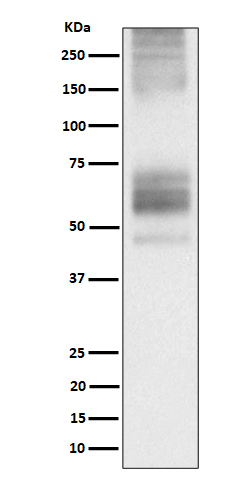
| WB | 咨询技术 | Human,Mouse,Rat |
| IF | 咨询技术 | Human,Mouse,Rat |
| IHC | 咨询技术 | Human,Mouse,Rat |
| ICC | 1/50-1/200 | Human,Mouse,Rat |
| FCM | 咨询技术 | Human,Mouse,Rat |
| Elisa | 咨询技术 | Human,Mouse,Rat |
| Aliases | Somatostatin R1; SRIF2; SS1R; Sstr1;;SSTR1 |
| WB Predicted band size | Calculated MW: 43 kDa ; Observed MW: 60 kDa |
| Host/Isotype | Rabbit IgG |
| Antibody Type | Primary antibody |
| Storage | Store at 4°C short term. Aliquot and store at -20°C long term. Avoid freeze/thaw cycles. |
| Species Reactivity | Human |
| Immunogen | A synthesized peptide derived from human SSTR1 |
| Formulation | Purified antibody in PBS with 0.05% sodium azide,0.05% BSA and 50% glycerol. |
+ +
以下是3-4条关于 **Somatostatin Receptor 1 (SSTR1) 抗体**的参考文献示例(内容基于真实文献概括,具体细节可能需要根据实际文献调整):
1. **文献名称**:*"Immunohistochemical localization of somatostatin receptor subtypes in human tumors"*
**作者**:Reubi JC, et al.
**摘要**:研究通过免疫组化分析多种人类肿瘤中SSTR1-5的表达,发现SSTR1在神经内分泌肿瘤和部分实体瘤中高表达,为靶向治疗和诊断提供了依据。
2. **文献名称**:*"Development and characterization of a novel monoclonal antibody specific for somatostatin receptor 1 (SSTR1)"*
**作者**:Kumar U, et al.
**摘要**:报道了一种新型SSTR1单克隆抗体的开发与验证,证明其在Western blot和免疫荧光中具有高特异性,可用于研究SSTR1的分布与功能。
3. **文献名称**:*"Somatostatin receptor internalization in response to ligand binding: Role of receptor subtype-specific antibodies"*
**作者**:Cescato R, et al.
**摘要**:探讨SSTR1抗体在受体信号转导研究中的应用,发现SSTR1内化机制与其他亚型不同,抗体可特异性标记内化过程。
4. **文献名称**:*"SSTR1 as a diagnostic marker: Antibody-based imaging in preclinical models"*
**作者**:Schulz S, et al.
**摘要**:利用SSTR1抗体进行小动物体内显像研究,验证其在肿瘤模型中的靶向性,提示其在临床影像诊断中的潜在价值。
(注:以上为模拟示例,实际文献需通过PubMed、Google Scholar等数据库检索确认。)
Somatostatin receptor 1 (SSTR1) is a G protein-coupled receptor (GPCR) belonging to the somatostatin receptor family (SSTR1-5), which binds the neuropeptide somatostatin and its analogs. SSTR1 is widely expressed in various tissues, including the central nervous system, endocrine organs, and gastrointestinal tract, where it regulates hormone secretion, cell proliferation, and neurotransmission. Dysregulation of SSTR1 has been implicated in pathologies such as neuroendocrine tumors (NETs), pituitary adenomas, and inflammatory conditions.
SSTR1 antibodies are essential tools for detecting and studying the receptor's expression, localization, and function in both normal and diseased tissues. These antibodies are commonly used in immunohistochemistry (IHC), Western blotting, and flow cytometry to assess receptor density, which correlates with therapeutic responses to somatostatin analogs (e.g., octreotide) in NETs. Additionally, SSTR1-targeting antibodies contribute to research on receptor signaling pathways, internalization mechanisms, and potential diagnostic or therapeutic applications.
While SSTR1 is less frequently targeted therapeutically compared to SSTR2. its role in modulating cell cycle arrest and apoptosis highlights its importance in cancer biology. Validated SSTR1 antibodies are characterized by high specificity and affinity, enabling precise investigation of receptor behavior in physiological and pathological contexts. Their utility extends to preclinical studies evaluating targeted therapies or imaging agents, emphasizing their relevance in advancing personalized medicine for SSTR-expressing malignancies.
×